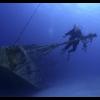Kimber is right. It is very important to understand the rules and also understand the safety issues both real and perceived.
As divers we must make decisions about our health when it comes to diving everyday. We choose who we give our business to and if they practice what we feel is an unsafe practice then we can choose to not give them business. OTOH...if we encourage a business to practice unsafe habits then we are guilty as well. But we must know what is fact, fiction, and common beliefs so we can make informed and educated decisions.
I know that I personally thought an 'overfill' or now adays called a 'cave fill' was great. WOW!!! Look how much more gas/air I have and how much safer I'll be with that reserve. Now that I know more about diving I realize that there is a reason that things like 'cave fills' and 'overfills' are a bone of contention. Many see them as harmless and others know in principal that they are harmful. The real trick is to find the appropriate middle ground.
And of course its all clear as mud!
I will say this...I got a 'cave fill' to 3600 psi in a tank last year on our annual Florida trip and it blew an o-ring in my first stage out. It ruined my dive...could have seriously hurt me if it had happened in the water and it almost ruined my second dive of the day. (I had to use borrowed gear which is never a preferred way of diving!) So in my book...serious overfills are not safe and they are not desired. I like my gear just as it is WAY too much to risk losing it over an 'overfill'.
I'd rather carry a bigger tank or a safety stage if I am worried about having enough air/gas to dive with.
Hi Kamala,
I'll bet, if you looked at all the SD.com trips run so far, 80 - 90 % of the trips only had AL 80's available, so while in an ideal world, a bigger tank tank or stage bottle would be best, realistically that's not even an option in the real world, thus my endorsement of the 'reasonable' cave fill...........also, remember, your gas consumption is much better than average ( female, 1000 + dives, minimal heat loss in dry suit 100 % of the time ) so you are much more 'satisfied' with what you can achieve on a 'mere' AL80, most of us aren't as 'efficient' as you with respect to gas usage.
...with respect to your 3600 psi cave fill, remember, you dive some 'vintage' Scubapro regs, designed/built when fill pressures were lower than today's 'standards', for example, a HP steel tank is rated at 3500 psi in the USA, so a 3600 psi fill is by no means a cave fill for a HP steel tank, although it would be for a LP steel tank commonly rated at 2640 psi. A 'modern' regulator with a DIN 1st stage is designed to cope with "HP" fills, these are fills starting at 3500 psi, so current day regulators are more than adequate to handle 'reasonable' cave fills.
FABER, which I believe is the world's largest scuba cylinder manufacturer, states its LP steel tanks are good for 10,000 fills @ 4000 psi...so again, going a few hundred psi beyond the 'official' DOT limit of 2640 psi is no big deal.
...for what it's worth, with respect to LP steel tanks, I'm comfortable with 3500 psi fills, for HP steel tanks, I'm comfortable with 4000 psi fills, for AL 80's, 3300--3500 psi, for AL 100's ( which are officially rated for 3300 psi ) I'm comfortable with 3700 -- 3800 psi fills...........however, for AL80's, the max pressures I ever see on trips are pretty much 3000 psi , the highest pressure I've ever dove with on an AL 80 was 3300 psi......the highest pressures I've ever seen anyone have on a dive trip were 4000 psi in a 3500 psi HP steel tank....no biggie..... and a 4000 psi fill on an AL80 on a fellow diver's tank, which was a little spooky, I'll admit.
Karl















